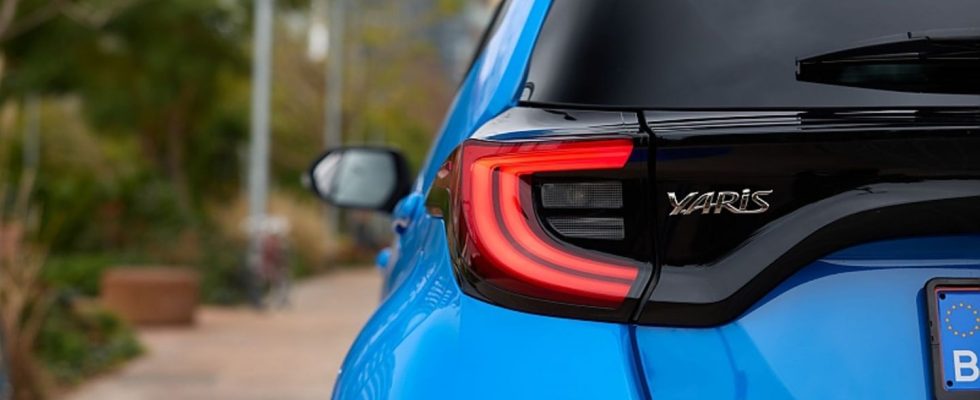Driving report: Toyota Yaris Hybrid 130
Gap winner
Toyota Yaris Hybrid 130
© press-inform – the press office
Toyota is refreshing the Yaris and giving the small car a more powerful hybrid drive, a digital cockpit and more assistance systems. But the improvements do not solve all problems.
For this project to be successful, a few optical retouches are not enough. This especially applies to infotainment. So the small car now also has a fully digital cockpit. Something that is already common practice with some competitors, but is making its debut in the Yaris. Previously there were two analogue round instruments with a small monitor in between. The Japanese car manufacturer is generally not known as a pioneer when it comes to such elements. But good: If the prophet doesn’t come to the mountain, the mountain will come to the prophet. So in the small Japanese car you can now enjoy virtual representations that are projected on a 12.3-inch screen, flanked by a 10.5-inch touchscreen (previously nine inches) and a head-up display.
This triad of ads is good for the small car. Especially since it fits into a more modern interior than was previously the case. The baroque appearance is a thing of the past; instead, there is a mobile phone charging cradle at the front, two USB-C ports, but also classic rotary and push buttons for operating the air conditioning. The menus and navigation on the large central display also appear more modern than before, as does the operation, which poses no puzzles. The modernization is accompanied by some new or improved assistance systems. This includes an emergency braking system (Emergency Driving Stop System, EDSS), which becomes active as soon as the driver does not operate the steering wheel, accelerator or brake pedal for a while. The technology then brakes the Yaris to a standstill, unlocks the doors and activates the hazard warning lights. The adaptive cruise control now regulates more sensitively, the proactive driving assistant (PDA) slows down when there are vehicles in front and helps when driving through the curve by adjusting the steering wheel restoring forces.
A lot is also happening with the drive. In addition to the hybrid with 85 kW / 116 hp, the Yaris gets a more powerful variant with 96 kW / 130 hp. If you look at the data sheet, you will be surprised to see that the electric motor with 62 kW / 82 HP only has 3 kW / 4 HP more power. So how do the additional 10 kW / 14 HP come about? The extra power comes from the Power Control Unit, which comes from the fifth generation of the hybrid drive, as used in the Corolla, among others, and, in conjunction with new software, stimulates a higher discharge capacity from the batteries. On paper, the increase in power reads well. This Yaris sprints from zero to 100 km/h in 9.2 seconds, 0.5 seconds faster than its narrower brother. What is even more important for drivability is the fact that torque increases by around 30 percent to 185 Newton meters.
As long as you only accelerate slightly, the small car, which weighs 1,180 kilograms, performs remarkably. But if you want to use full power, the three-cylinder growls audibly, but the propulsion cannot keep up with the acoustic noise. Ultimately, it only makes a marginal difference whether you choose the Eco, Normal or Sport driving program. By changing the gear ratio often using the six-speed manual transmission, you can at least somewhat disguise the lack of temperament. The fact that the beefed-up Yaris can only reach a maximum speed of 175 km/h after its fitness treatment also doesn’t quite fit with the dynamic look. We like the steering and chassis more. Both are binding without exaggerating it with artificially generated sportiness, which leads to calm handling in curves and on bad roads. The little Toyota once again deserves praise when it comes to fuel consumption: After our test drive, the on-board computer reported an average thirst of 5.4 l/100 km, which is 1.2 l/100 km more than the data sheet shows.
In a small car with a length of 3.94 meters, the amount of space is naturally not particularly generous. The facelifted Yaris also fits in there. There is hardly any space for adults in the rear and the trunk is standard for the segment with a volume of 768 liters. If you fold down the backrests of the back seat, the capacity increases to 768 liters (with a window-high load). The fact that the surface is flat makes filling the luggage compartment easier.
Finally, there is a big “but”: The more powerful Toyota Yaris is only available from the Style trim level onwards. At a price of 31,900 euros, it’s not exactly cheap and costs 4,400 euros more than the popular club version of the model with 85 kW / 116 hp. The Premiere Edition we tested costs 34,900 euros. Toyota assumes that around 30 percent of Yaris buyers will choose the more powerful drive variant. When asked whether it is also conceivable to offer this engine in the cheaper models, Markus Burgmer, product manager at Toyota Germany, answers in the best Franz Beckenbauer manner with “Let’s see!” This means that the sales strategists monitor the market closely and “democratize” this product if the customers want it.

